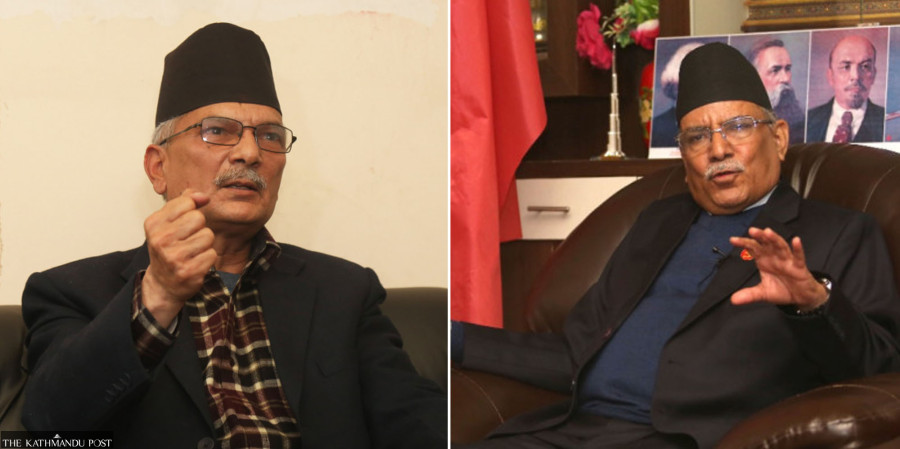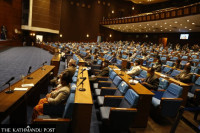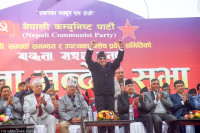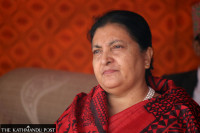Politics
Baburam Bhattarai comes full circle seven years after quitting Maoist party
Looming polls and poor prospects force the former Maoist to join hands with Dahal. Bhattarai’s Nepal Samajbadi will contest election under the Maoist symbol and manifesto.
Tika R Pradhan
After being together for close to three decades and leading the decade-long “people’s war,” Baburam Bhattarai in September 2015, days after the promulgation of the constitution, decided to part ways with his boss Pushpa Kamal Dahal.
One of the major agendas of the “people’s war” was writing a new constitution through a Constituent Assembly, which would guarantee Nepal as a secular federal republic.
Dahal continued to lead the Maoist party, which after changing names multiple times is currently the CPN (Maoist Centre). Bhattarai launched his Naya Shakti Party in 2016 with a view to establishing an alternative force. After it failed, he merged the party with Upendra Yadav’s Sanghiya Samajbadi Forum in 2019 to form the Janata Samajbadi Party (JSP). The JSP merged with the Rastriya Janata Party in 2020 to become the Janata Samajbadi Party of which Bhattarai was federal council chair until July 14.
He registered a new party on July 28—the Nepal Samajbadi Party.
Now, seven years after their separation, Dahal and Bhattarai are coming together again. Bhattarai has not joined the Maoist party nor has he merged his party with it. But both on Sunday reached an agreement to contest the upcoming polls together—under a common election symbol and manifesto.
“The two parties have reached a verbal agreement to contest the polls under a common election symbol and manifesto,” Bishwadeep Pandey, chief of the publicity department of the Nepal Samajbadi Party, told the Post.
Bhattarai’s Nepal Samajbadi Party has “eye” as its election symbol, but he and Dahal have agreed to fight the elections under the Maoist Centre’s “hammer and sickle within a circle.”
The agreement between the two leaders has now stoked speculations if they are planning to build a “socialist centre,” an idea Bhattarai has been pitching for long.
Ever since he left the Maoist party, Bhattarai has been saying that the country needs a socialist force for the political, social and economic transformation of the country, arguing that such changes are not possible by the traditional communist parties and the Nepali Congress.
Dahal, on the other hand, appears to be keen on shedding the “Maoist” tag.
Observers say a socialist centre may remain just an idea as of now as the latest agreement between Dahal and Bhattarai seems to have been guided more by their personal political interests as elections are approaching.
While Bhattarai finds himself at a crossroads—his new party lacks organisational base—Dahal is desperate to improve his party’s poll prospects as he wants to become not only a strong kingmaker after the elections but also prime minister.
Even though they might sell the socialist centre idea during the election campaign, they are likely to try to woo the “Maoist” voters by giving a message that they are together and there’s still a lot to achieve, observers say.
While in the Maoist party, Dahal and Bhattarai shared a love-hate as well as symbiotic relationship. The former was known as a rabble-rouser, a leader of the masses, while the latter was more like an ideologue. Both had a mutual need for each other.
“Both Dahal and Bhattarai are facing an existential crisis and they are in a bid to increase their strength,” said Jhalak Subedi, a political commentator. “There seems to be extreme pressure both on Dahal and Bhattarai from their members for a merger.”
According to Subedi, though Bhattarai’s new followers have deserted him, those from Maoist backgrounds could return to the party if he merges his party with the Maoist Centre.
After the Maoist party laid down arms in 2006 and emerged as the single largest party in 2008, Bhattarai became finance minister in the Dahal-led Cabinet. The government, however, collapsed in 10 months. Bhattarai became prime minister from August 2011 to March 2013. But by the time the constitution was promulgated in 2015, the two Maoist leaders had fallen out with each other.
Now the polls have brought them together.
According to Ram Karki, a politburo member of the Maoist Centre, Bhattarai’s comeback is part of the campaign to bring back all former Maoist leaders and cadres under one roof.
“Bhattarai had to rethink his previous decisions after his plans didn’t work,” Karki told the Post. “He is one of the leaders for whom there was a lot of respect in the Maoist party.”
Observers say Bhattarai was in dire need of someone to piggyback on, and he must have realised his former party would be the best bet. Over the past years, he had been gradually alienated, with even people close to him deserting him.
“Obviously, it’s Bhattarai who needed a ride more than Dahal, as he was being left with no option after his bids to create an alternative force failed,” said Subedi.
How Dahal and Bhattarai are going to work out seat-sharing, however, is yet to be seen. Dahal’s Maoist party is a key partner in the ruling coalition where he has been pressing the Nepali Congress for more seats. Ever since Bhattarai formed his new party, he has not been part of the coalition.
Bhattarai may seek at least one seat each for him and Mahindra Rai Yadav, who has also quit the JSP to become the chair of the Nepal Samajbadi Party. Yadav won from Sarlahi-2.
Some leaders who supported Bhattarai’s bid to develop an alternative force said what they had suspected about the former Maoist leader had come true.
“Bhattarai has turned out to be an opportunist,” said Dambar Khatiwada, who was close to him ever since Bhattarai formed the Naya Shakti. “I would rather say a leftist opportunist. There should be morality in politicians.”
Khatiwada said he is no longer with Bhattarai now.
“Bhattarai had said he had not only left the Maoist party but also stopped believing in the Marxist and Leninist ideology. But actually he could never shed his Maoist character,” he added.
Despite expressing his loathing for communists, Bhattarai in 2017 had almost joined the left alliance when the CPN-UML and the Maoist Centre planned a grand left force. But he was left out as Dahal and UML chair KP Sharma Oli went ahead. The alliance did work in the 2017 elections, but Oli and Dahal fell out with each other. Dahal sided with the Nepali Congress to cause Oli’s fall. Local elections under an alliance with the Congress and other three parties gave his party a new lease of life, and he is in a bid to increase his bargaining power, analysts say.
Mumaram Khanal, a former Maoist leader who had even joined Naya Shakti only to quit in no time, says Bhattarai has joined hands with Dahal with an intention to merge his party.
“Bhattarai was hesitating to return to Dahal’s fold because he had earlier said he did not believe in communism anymore. But if he can secure his electoral constituency, he could go to any extent,” Khanal told the Post. “It could take some time, but Bhattarai most likely will merge with the Maoist Centre by asking Dahal to change the party name.”
Dahal, on the other hand, according to Khanal, is in a bid to make his party first among the leftist forces and he sees a chance of it with this union with Bhattarai.
“It’s true that both Dahal and Bhattarai lost significant strength after they parted ways,” said Khanal. “But it’s unlikely they will be able to recoup the loss by joining hands now.”
On August 7, Bhattarai asserted his mission on Twitter with quotes by Thomas A Edison and Ralph Waldo Emerson to assert his mission.
“My mission and motto in life is reflected in these two quotes: 1. “I have not failed. I’ve just found 10,000 ways that won’t work.” - Thomas A. Edison; 2. “Do not go where the path may lead; go instead where there is no path & leave a trail”. - Ralph Waldo Emerson [SIC],” Bhattarai wrote on the micro-blogging site, appending it with a link to a Post story about him.
Only time will tell if the former Maoist leader will find one more way that does not work—or work—or will indeed be able to leave a trail as he seeks a refuge in his old abode.




 7.12°C Kathmandu
7.12°C Kathmandu















